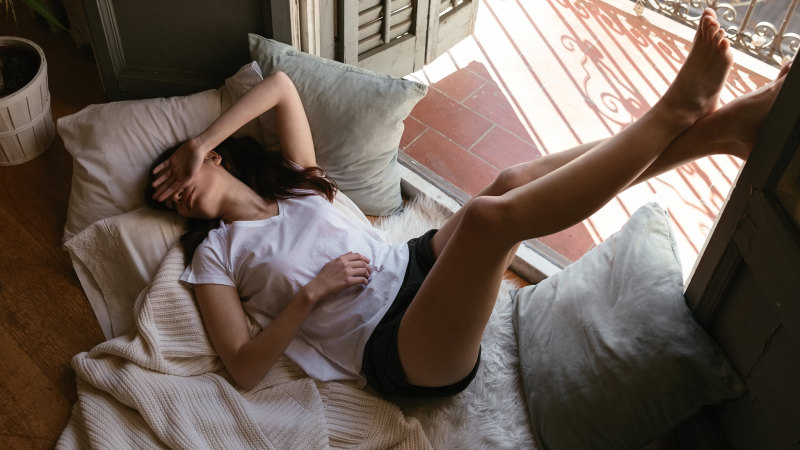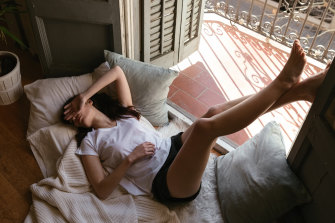Rochelle De Luca knew something wasn’t quite right when she couldn’t easily walk up a hill. The 36-year-old personal trainer and co-founder of Reunion Training decided to take a COVID-19 test the next day and, just as her suspicions she was positive were confirmed, the pain started.
“That morning, on a drive back to Sydney, my back started aching and I couldn’t even sit in the car properly. Then I had around seven days of fevers, chills and shakes. And when that subsided, I started getting really heavy chest pains.”
For Rochelle, who used to be able to do four back-to-back sessions in the gym, it took eight weeks for her to feel 80 per cent recovered.Credit:Stocksy
While Rochelle was double vaccinated, she hadn’t been boosted. After being concerned for days about her irregular heartbeat, she finally went to hospital on day nine when she was unable to take in a full breath.
“It was absolutely terrifying,” she recalls. “I had blood tests, an ECG and an X-ray. Then they gave me a painkiller, said there was nothing more they could do, and sent me home to my own bed.”
Rochelle visited her GP the next day and was given three kinds of antibiotics. Finally, about 48 hours later, her lungs felt clearer. “But I still couldn’t go for a walk or do anything around the house. I could just sit up and breathe.”
When her 14 days of self-isolation ended, Rochelle attempted to go for a walk and found she had gone from being extremely fit to needing to stop to rest as she puffed her way to the end of the street. Meanwhile, when her 94-year-old grandmother tested positive for COVID, she had no symptoms.
Dr Selina Parry says we need to understand that COVID will impact people in different ways and that our bodies will have varying symptoms and severities. A senior lecturer at the University of Melbourne’s Department of Physiotherapy, where she specialises in intensive-care patient recovery, Parry says that while the evidence for COVID recovery is still emerging, the recommendation is to wait at least three to seven days after your symptoms have resolved and then start moving gently and slowly.
“It’s important to get moving again but you don’t want to push through,” she says. “It’s about listening to your body and not exacerbating symptoms. You want to be looking out for signs
of exhaustion and excessive fatigue, as well as heart rhythm irregularities and higher levels of breathlessness than you might expect.”
Parry says that once you are able to have a full conversation with someone without difficulty, start with gentle walks, yoga and day-to-day tasks such as gardening and housework. Gradually build up to 30 minutes of light-intensity exercise.
For those whose heart and lungs have been impacted by COVID, Parry says it’s important to see a GP, and to consider going to a physiotherapist or exercise physiologist. “They have really great backgrounds in knowing how to tailor a program based on different symptoms or different levels of fitness.”
For Rochelle, who used to be able to do four back-to-back sessions in the gym, it took eight weeks for her to feel 80 per cent recovered, and to be able to get on an exercise bike again “without feeling like my chest was falling in and that my lungs were heavy”.
Rochelle is now helping others in their own post-COVID recovery journey and says it’s vital to be in tune with your body. “You can’t push past it. The best advice I can give is to listen to your body and be kind to it.”
To read more from Sunday Life magazine, click here.
Make the most of your health, relationships, fitness and nutrition with our Live Well newsletter. Get it in your inbox every Monday.
Most Viewed in Lifestyle
From our partners
Source: Read Full Article

